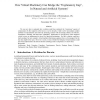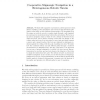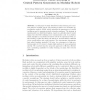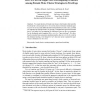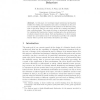118
click to vote
SAB
2010
Springer
14 years 10 months ago
2010
Springer
We study self-organized cooperation in a heterogeneous robotic swarm consisting of two sub-swarms. The robots of each sub-swarm play distinct roles based on their different charac...
105
click to vote
SAB
2010
Springer
14 years 10 months ago
2010
Springer
Abstract. In this paper we study distributed online learning of locomotion gaits for modular robots. The learning is based on a stochastic approximation method, SPSA, which optimiz...
SAB
2010
Springer
14 years 10 months ago
2010
Springer
Two main theories of female mate choice, that females either pick the best from the n closest males (best-of-n) or the closest with some minimum quality (min-threshold), make diffe...
121
click to vote
SAB
2010
Springer
14 years 10 months ago
2010
Springer
Abstract. Symmetry breaking is commonly found in self-organized collective decision making. It serves an important functional role, specifically in biological and bio-inspired sys...
SAB
2010
Springer
14 years 10 months ago
2010
Springer
In this paper, we investigate simple attentional mechanisms suitable for sensing rate regulation and action coordination in the presence of mutually dependent behaviors. We present...
SAB
2010
Springer
14 years 10 months ago
2010
Springer
Abstract. We propose an integrated model of the saccadic circuitry involved in target selection and motor command. It includes the Superior Colliculus and the Basal Ganglia in both...
108
click to vote
SAB
2010
Springer
14 years 10 months ago
2010
Springer
We introduce a new bee-inspired routing protocol for mobile ad hoc networks. Emphasis is given to the ability of bees to evaluate paths by considering several quality factors. In o...
SAB
2010
Springer
14 years 10 months ago
2010
Springer
Abstract. For autonomy in underwater robotics it is essential to develop context-driven controllers, capable of leading from perception to action without human intervention. One of...
SAB
2010
Springer
14 years 10 months ago
2010
Springer
Biological brains can adapt and learn from past experience. In neuroevolution, i.e. evolving artificial neural networks (ANNs), one way that agents controlled by ANNs can evolve t...
